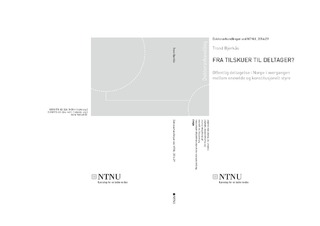| dc.contributor.advisor | Bull, Ida | |
| dc.contributor.advisor | Njåstad, Magne | |
| dc.contributor.author | Bjerkås, Trond | |
| dc.date.accessioned | 2017-01-31T09:22:38Z | |
| dc.date.available | 2017-01-31T09:22:38Z | |
| dc.date.issued | 2016 | |
| dc.identifier.isbn | 978-82-326-1401-1 | |
| dc.identifier.issn | 1503-8181 | |
| dc.identifier.uri | http://hdl.handle.net/11250/2428996 | |
| dc.description.abstract | Sammendrag av avhandlingen:
Avhandlingen drøfter gjennom fire artikler hvordan det lokale selvstyret i Norge på 1800-tallet vokste fram fra praksiser og institusjoner med røtter i enevoldssamfunnet. Sentralt i analysen står begrepet lokaloffentlighet, definert som institusjoner, praksiser og normer som styrer myndighetsutøvelse og kommunikasjon mellom myndighetene og befolkningen. Ved å ta utgangspunkt i lokaloffentligheten, utfordrer avhandlingen sentrumsorienterte forestillinger om at 1800-tallet var en «embetsmannsstat» og at hovedkonfliktaksen på 1800-tallet gikk mellom embetsmannsstat og bønder. I stedet skisserer avhandlingen en utvikling fra eneveldets manifesterende offentlighet, som iscenesatte et skarpt skille mellom statsmakten på en ene siden og befolkningen på den andre, til 1800-tallets «integrerte» offentlighet. I denne deltok stemmeberettigede bønder på prinsipielt likeverdige premisser, samtidig som andre grupper i bondesamfunnet ble ekskludert.
I motsetning til etablerte fortolkninger, argumenterer avhandlingen for at denne utviklingen i stor grad må forklares som resultat av endringer innad i eneveldets styringspraksis. Eneveldet trakk selv deler av befolkningen inn i styringen for å administrere en voksende «offentlig sektor». Dette var ledsaget av endringer i styringsideologien, som fremhevet frihet og ansvar på bekostning av tukt og formaning.
I denne konteksten blir Grunnlovens betydning først og fremst vurdert å gi en ny fortolkningshorisont til allerede eksisterende praksiser og institusjoner. Lekmannselementer i lokaloffentligheten kunne i lys av folkesuverenitetsideen etter 1814 forstås som representanter for allmuen. Samtidig utgjorde Grunnloven en ny forfatningsmessig overbygning som fremhevet de sosio-økonomiske skillene innad i bondesamfunnet, og tydeliggjorde hvem som var inkludert og hvem som var ekskludert fra det nye politiske fellesskapet.
Avhandlingens fire artikler undersøker hver sine lokaloffentlige institusjoner i undersøkelsesperioden. I motsetning til hovedvekten av tidligere forskning, ligger fokus her på kirkelige institusjoner. Dette fyller et hull i forskningen og henleder oppmerksomheten på en underkommunisert faktor i norsk historie – kirkens betydning for utformingen av den politiske kulturen i det moderne norske samfunnet. | nb_NO |
| dc.description.abstract | Summary of the thesis:
Through four articles, the thesis discusses how local self-government in Norway in the 19th century grew out of practices and institutions rooted in absolutist society. At the center of the analysis is the concept of the local public sphere, understood as institutions, practices and norms that define governance and communication between government and population. By taking the local public sphere as a point of departure, the thesis challenges traditional center-oriented views such as the notion that Norway in the 19th century was a ”civil-servant state”, and that that the main axis of conflict in the 19th century was between this civil-servant state and the peasantry. Instead, the thesis outlines a development from a “manifesting” public sphere under absolutism, which highlighted a sharp distinction between the State on the one hand and the population on the other, to an “integrated” public sphere in the 19th century. Here peasants with voting rights participated on principally equal terms, while at the same time other groups within the agricultural society were excluded.
As opposed to established interpretations, the thesis explains this development to a large degree by changes within the governmental practices of the absolutist regime. The regime itself drew elements of the population into local government in order to administer a growing “public sector”. This was accompanied by changes in the ideology of government, which gradually emphasized freedom and responsibility at the expense of discipline and admonishment.
In this context, the relevance of the Constitution of 1814 was primarily to provide a new interpretative horizon. After 1814, ley elements in the local public sphere could be interpreted as representatives of the populace, in light of the concept of popular sovereignty. At the same time, the Constitution provided a new constitutional super-structure that highlighted the socio-economic differences within the agricultural society, and explicated who were included and who were excluded from the new political community.
The four articles each explore different institutions of the local public sphere. As opposed to the main body of earlier research, the focus in the present thesis is on institutions connected to the church. This helps to remedy a lacuna in the existing literature, and points to an underexplored element in Norwegian history – the importance of the church in the development of the political culture in modern Norwegian society. | nb_NO |
| dc.language.iso | nob | nb_NO |
| dc.publisher | NTNU | nb_NO |
| dc.relation.ispartofseries | Doctoral theses at NTNU;2016:29 | |
| dc.relation.haspart | Paper 1:
Bjerkås, Trond.
Fra eneveldets scene mot representative forsamlinger: visitasen som offentlig arena i Norge, ca. 1750-1850. Sjuttonhundratal 2015 ;Volum 12. s. 183-211
http://dx.doi.org/10.7557/4.3531
Attribution 3.0 Unported (CC BY 3.0) | |
| dc.relation.haspart | Paper 2:
From the parish to the public realm
–changing terms of local government in Norway between absolutism and constitutional
rule. | |
| dc.relation.haspart | Paper 3:
, Trond.
Grunnloven og lokaloffentligheten. En undersøkelse av Grunnlovens betydning for fattig- og skolekommisjonene, ca. 1790-1830. I: Riket og regionene. Grunnlovens regionale forutsetninger og konsekvenser. Akademika forlag 2014 ISBN 978-82-321-0374-4. s. 97-133 | |
| dc.relation.haspart | Paper 4:
Bjerkås, Trond.
Fellesskap, lederskap, utenforskap: Autoritet og fellesskapsnormer i kommunestyrene mellom 1837 og 1850. Historisk Tidsskrift 2016 ;Volum 95.(1) s. 34-66 | |
| dc.title | FRA TILSKUER TIL DELTAGER? Offentlig deltagelse i Norge i overgangen mellom enevelde og konstitusjonelt styre | nb_NO |
| dc.type | Doctoral thesis | nb_NO |
| dc.subject.nsi | VDP::Humanities: 000::History: 070 | nb_NO |
